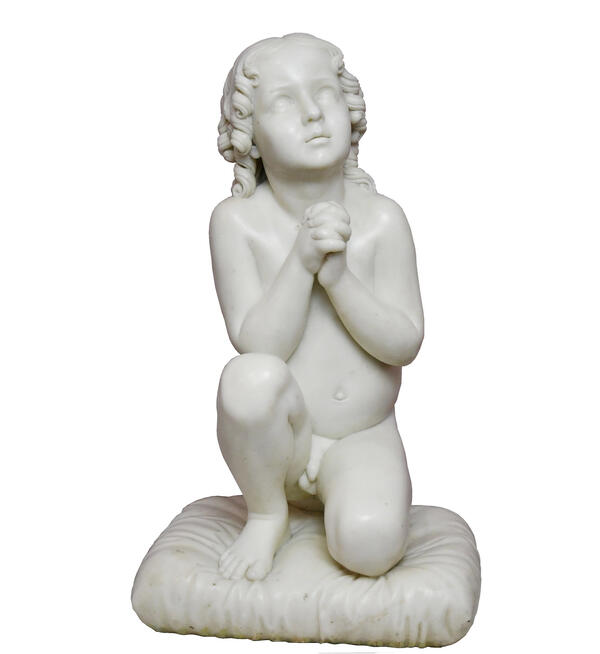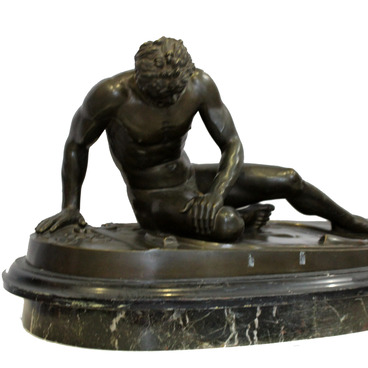The Syzran Museum of Local History and Lore acquired the Praying Boy sculpture in 1927 from the funds of the Chief Directorate for the Management of Research, Arts, and Museums. The same sculpture exhibited at the State Hermitage Museum is titled a Boy Who Just Let Go of a Bird, the one exhibited at the Tambov gallery is known as a Praying Boy, and the one exhibited at the Yaroslavl art museum is titled Samuel in Prayer.
The boy was sculpted by an unknown master and is a copy of the famous Kneeling Child at Prayer sculpture by Italian sculptor Luigi Pampaloni (1791–1847), who is generally regarded as a representative of the Florence school. He created the original sculpture on commission for the Polish count František Potocki. The artist displayed his piece to the public in the fall of 1826. Over time, the sculpture became very popular across Europe, and lots of copies were made. The author copied it himself a lot too.
The sculpture was often used on tombstones in Italy, France, England, and Poland. Known copies made by Luigi Pampaloni are kept at Palazzo Tosio in Brescia as well as Palazzo Bianco in Genoa. One of the author’s copies (with a chiseled signature of Luici PAMPALONI Fce) was purchased in 1978 for the Ostankino Estate Museum.
After getting the order from the Polish count, Luigi Pampaloni carved a kind of an idealized boy from a piece of marble rather than a portrait in the sculpture of any specific boy. This kind of attitude towards sculpture traces its roots to Ancient Greece. The gracefully rendered beauty of the naked human body, which inspired the sculptors of antiquity and the Renaissance, was inherited by the sculptors of the Enlightenment. Rehashing of the ancient and classical traditions in the 19th century became known as neoclassicism, and the Praying Boy is a typical example of that trend.
The master had a very good understanding of the material and a good knowledge of human anatomy so he was able to render the softness of a child’s skin, the lightness of his hair, and the proportions of the human body in hard stone. The hands put together in prayer, the knees, and the muscles all look like they were real. The sculpture combines idealized form with an accurate depiction of a child’s impulsive sincerity in expressing one’s feelings. The sculpture shows the innocence of a child’s soul: it is open and at the same time vulnerable to this world, which can at times be cruel and unfair. The praying boy’s face is focused, attentive, and frank.
The boy was sculpted by an unknown master and is a copy of the famous Kneeling Child at Prayer sculpture by Italian sculptor Luigi Pampaloni (1791–1847), who is generally regarded as a representative of the Florence school. He created the original sculpture on commission for the Polish count František Potocki. The artist displayed his piece to the public in the fall of 1826. Over time, the sculpture became very popular across Europe, and lots of copies were made. The author copied it himself a lot too.
The sculpture was often used on tombstones in Italy, France, England, and Poland. Known copies made by Luigi Pampaloni are kept at Palazzo Tosio in Brescia as well as Palazzo Bianco in Genoa. One of the author’s copies (with a chiseled signature of Luici PAMPALONI Fce) was purchased in 1978 for the Ostankino Estate Museum.
After getting the order from the Polish count, Luigi Pampaloni carved a kind of an idealized boy from a piece of marble rather than a portrait in the sculpture of any specific boy. This kind of attitude towards sculpture traces its roots to Ancient Greece. The gracefully rendered beauty of the naked human body, which inspired the sculptors of antiquity and the Renaissance, was inherited by the sculptors of the Enlightenment. Rehashing of the ancient and classical traditions in the 19th century became known as neoclassicism, and the Praying Boy is a typical example of that trend.
The master had a very good understanding of the material and a good knowledge of human anatomy so he was able to render the softness of a child’s skin, the lightness of his hair, and the proportions of the human body in hard stone. The hands put together in prayer, the knees, and the muscles all look like they were real. The sculpture combines idealized form with an accurate depiction of a child’s impulsive sincerity in expressing one’s feelings. The sculpture shows the innocence of a child’s soul: it is open and at the same time vulnerable to this world, which can at times be cruel and unfair. The praying boy’s face is focused, attentive, and frank.


